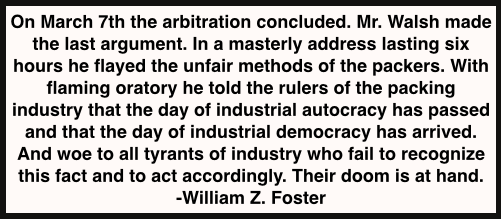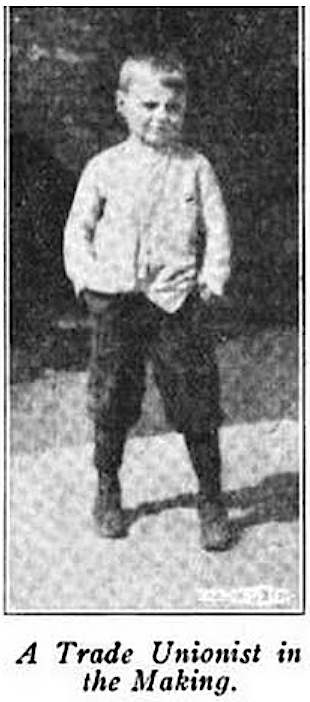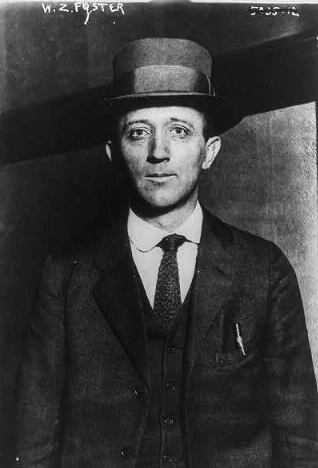
Hellraisers Journal, Sunday April 7, 1918
Victory! for Packinghouse Workers by William Z. Foster, Part III
From Life and Labor of April 1918:
HOW LIFE HAS BEEN BROUGHT
INTO THE STOCKYARDS
A Story of the Reorganization of the Packing IndustryWilliam Z. Foster
Secretary Chicago Stockyards Labor CouncilThe main questions, touching wages, hours and conditions of labor, involved in the Stockyards arbitration hearing before Judge Alschuler, and his decision concerning them, are of overwhelming importance, both in principle and in consequence. Just how far-reaching will be the results of the decision one cannot now forecast. But lips stiffened by poverty will perhaps now learn to smile, and thousands of families will for the first time taste of life.
[Part III]
THE SHORTER WORKDAY
A big battle raged around the question of the eight hour day. In this measure’ the packers saw typified the victory so earnestly sought by the workers. They bent every effort to defeat it. Although compelled to admit the justice, economy and inevitability of the eight hour day as a general proposition, they exhausted every pretext to prevent its consideration, for very obvious reasons, till after the war.
Their strong argument was that, due to the irregular supply of cattle, sheep and hogs, and the limited capacities of the plants, introduction of the eight hour day could only be brought about after months and years of rebuilding and other preparation. To establish it suddenly now would be disastrous. It would reduce the production of vitally necessary foodstuffs full 20 per cent. This would involve starvation for the boys in the trenches and very possibly the loss of the war.
To establish this contention the brainiest superintendents in the packing business piled complexities upon complications. But their efforts were in vain. The workers met and defeated them at every point. Samuel Gompers and Victor A. Olander made the general argument for the shorter workday, and a masterful one it was. Dennis Lane, John Kennedy, Martin Murphy, Tim McCreash, John Joyce and Joseph Selkirk, all skilled butchers, applied it to the packing houses. These union workers destroyed every technical objection raised by the superintendents, checking them one by one. Once, in the midst of the arbitration, they even went to Kansas City to ascertain the exact capacity of certain departments of the packing plants in that city. They routed the experts, horse, foot and dragoons, and proved beyond all question of doubt the practicability and economy of immediately establishing the eight hour day in the packing industry. At the first hour, seeing they were defeated, the packers urged the administrator in case he saw fit to shorten the workday, to make it apply only to the skilled trades—an insidious attack on the unions that did not pass without thorough exposure.
EQUAL PAY FOR MEN AND WOMEN
Much was said of this fundamental measure. As usual, the packers tried to avoid the issue. With much ado they announced their undying fealty to the principle of equal pay for male and female workers. But they denied that there were any men and women doing the same kind of work in their plants. They had “reclassified” the work and made it lighter for the women. That is to say, a women working side by side with a man and doing identical work should be paid from 10 to 15 cents per hour less simply because, from time to time, the man lifts a box from the work bench, or nails a cover on it.
The workers mercilessly exposed this pitiful subterfuge, and showed that in spite of it many women workers are doing exactly the same work as men for much less pay. They asked the administrator, in view of the great complexity of the problem, to establish the principle of equal pay. Later on they would take up the cases in the various departments where the “reclassificaion” scheme is in effect and treat them as grievances.
THE AWARD
On March 7th the arbitration concluded. Mr. Walsh made the last argument. In a masterly address lasting six hours he flayed the unfair methods of the packers. With flaming oratory he told the rulers of the packing industry that the day of industrial autocracy has passed and that the day of industrial democracy has arrived. And woe to all tyrants of industry who fail to recognize this fact and to act accordingly. Their doom is at hand.
In a document of 7,000 words Judge Alschuler, on March 30th, brought in his findings on the six questions at issue. They reflect genuine credit upon him as a fair-minded man. In brief, they are as follows:
1. The basic eight hour day; to become effective May 5th, 1918.
2. Double time for Sundays and six holidays; time and one-fourth for the ninth and tenth hours, and time and one-half for all over ten hours on regular workdays.
3. Where three eight hour shifts are worked daily, employes to be allowed 20 minutes off for lunch with pay.
4. Wage increases of from 3½ to 4½ cents per hour, the lowest paid workers to get the larger increases. New rates to be effective as of January 14th. When basic eight hour day becomes effective on May 5th employes shall be allowed ten hours pay for eight hours work.
5. Equal pay for men and women doing the same class of work.
6. A guarantee of five days work per week.
In determining the wage increases and overtime rates the administrator stated he had been influenced by the consideration that, due to war needs, much overtime work was inevitable. Therefore the moderate rates. As it now stands a laborer gets $2.75 for ten hours; under the new rates he will get, for ten hours work, $4.20; that is, $3.20 for the basic eight hour day and $1 for the additional two hours. For Sunday work, and it is plentiful, the laborer will be paid 80 cents per hour instead of 27½, as before.
On Easter, Sunday, March 31st, in a monster open air meeting 40,000 packing house workers assembled and endorsed the award.
CONCLUSION
Between the articles agreed upon by the unions and the packers, and those handed down by the administrator, the foundations of Trade Union principles and practices are firmly established in the packing industry. Strong organizations, the recognized right to organize and to bargain collectively, machinery to handle grievances, the basic eight hour day, extra rates for overtime, Sundays and holidays, one day’s rest in seven, equal pay for men and women, the principle of seniority, 30 day competency clause, guaranteed time—with these weapons in their hands the packing house workers will be well able to fight their way onward to the new freedom.
Great things have been done in the packing industry. An army of oppressed slaves have been put safely on the way to freedom and happiness. And the credit lies with the live spirits of the organizations involved. Never did a group of unionists work more earnestly and faithfully together than they. With hearts and minds set firmly upon the ideal of an organized packing industry, they let nothing stand in the way of its achievement. Progress, determination, energy, sincerity and loyal cooperation were their watchwords. Craft bickerings, personal jealousies, time-honored precedents and revered but outworn tactics they threw to the four winds. They obliterated the very thought of failure and tolerated only those factors making for success. And the natural result is now patent to all—one of the greatest victories ever won by Organized Labor.
What has been done in the packing industry can be done elsewhere just as readily. If so many large industries are unorganized the Trade Union movement is alone to blame. Too often its tactics are fitted to the nineteenth century rather than to the twentieth. Before anything substantial can be done in the big job of organization confronting us the various unions will have to abandon their suicidal jurisdictional quarrels, give up their antiquated policy of individual dabbling and unite themselves loyally in widespread movements inspired with a burning spirit of labor solidarity. When this is done, then the labor movement will take on a growth and prosperity now hardly conceivable, and tremendous strides will be made towards the long-dreamed-of goal of industrial emancipation.
———-
SOURCE & IMAGES
Life and Labor, Volume 8
-Jan to Dec 1918
National Women’s Trade Union League, 1918
https://books.google.com/books?id=8JBZAAAAYAAJ
L&L April 1918
https://play.google.com/books/reader?id=8JBZAAAAYAAJ&printsec=frontcover&pg=GBS.PA62-IA1
Life Into Stockyards by WZF
https://play.google.com/books/reader?id=8JBZAAAAYAAJ&printsec=frontcover&pg=GBS.PA63
See also:
Hellraisers Journal, Friday April 5, 1918
Victory! for Packinghouse Workers by William Z. Foster, Part I
On the Alschuler Award: “How Life Has Been Brought into the Stockyards”
Hellraisers Journal, Saturday April 6, 1918
Victory! for Packinghouse Workers by William Z. Foster, Part II
On the Alschuler Award: “How Life Has Been Brought into the Stockyards”
“Frank P. Walsh‐Labor’s Tribune”
Expanded from a talk given October 17 and 24, 1992
by Judy Ancel, Director
The Institute for Labor Studies
http://cas2.umkc.edu/labor-ed/documents/FrankWalshLaborsTribune.pdf
Pages from a Worker’s Life
-by William Z. Foster
International Publishers, 1970
(See pages 152-159.)
https://books.google.com/books?id=2cNUcAAACAAJ
From pages 152-153:
[J]ust before the World War I…a small group of steamfitters in the Chicago plant of Armour and Company…suffered from a special grievance that was particularly onerous. [Therefore] they went to the great lengths (in this totally unorganized industry) of asking a local trade union official to go with them to Armour’s office to try to settle it.
To the surprise of the committee they were ushered into the palatial office of a Vice-President of Armour and Company. The union spokesman outlined their trouble, pointing out how hard the condition was on the men and how little it would cost the firm to correct it. The company official listened to all this and then casually remarked, “It’s nice weather lately, don’t you think?”
The workers were astonished. Their spokesman, thinking perhaps the Vice-President was absent-minded and not paying attention, went briefly over the matter again.But the boss, turning towards his broad window, said nonchalantly, “They tell me they have been having some big storms in the South recently.”
By this time the workers realized what was happening; this autocrat was deliberately insulting them. Boiling with indignation, their leader said to him, “So that’s the answer of Armour and Company to its workers when they present a grievance; you sneer at us by talking about the weather.”
At this the Vic-President, rising from his chair and advancing belligerently towards the workers, shouted,”Yes, that’s Armour’s answer. Go back to your trade union friends and tell them Organized Labor will never get anything from this company that it hasn’t the power to take.”
I never forgot those cold, cynical words, nor did I fail to draw the full class-struggle logic from them. And I daresay this same Vice-President also recalled them when, a few years later, he faced our union committee representing two hundred thousand organized packinghouse workers. Let it be known that this time he found something more vital to talk about than weather.
In 1917-18, the organizing movement of packinghouse workers, conducted by a federation of a dozen A.F. of L. unions, resulted in the complete national organization of the industry, two hundred thousand workers. It was the first mass production industry of the United States to be unionized, Jack Johnstone and [William Z. Foster], leading the movement, aimed at a countrywide war-time strike if need be, because we knew that such a strike would be short, sharp and victorious. But the government, packers and A.F. of L. leaders switched the developing struggle into arbitration and maneuvered the control of the industry under an Administrator, Federal Judge Alschuler…
[Photographs and emphasis added.]
Note: the Alschuler Award was the result of a hard-fought organizing campaign. President Wilson and Labor Secretary Wilson did not concern themselves with the welfare of the packinghouse workers until they were organized, 200,000 strong, and a force to be reckoned with.
Photos:
William Zebulon Foster ab/ 1920, 1881-1961
http://www.loc.gov/pictures/item/2004677536/
See also: Jack Johnstone
http://www.illinoislaborhistory.org/biographies-i-k/#jack
Workingclass Giant
The Life of William Z. Foster
-by Arthur Zipser
International Publishers, 1981
(See pages 42-47.)
https://books.google.com/books?id=1Z63AAAAIAAJ
From page 47:
Less than a year had passed since Bill Foster got the bright idea to organize packinghouse. Now,[after the March 30, 1918, Alschuler Award, followed by a short strike to bring the Stockyards into line] for the first time in U.S. labor history, an entire mass production industry had been organized; and in a single great drive 25,000 Black workers had become union members. Foster’s prestige was tremendous. In his first real try he had proved himself to be the greatest labor organizer in the country.


